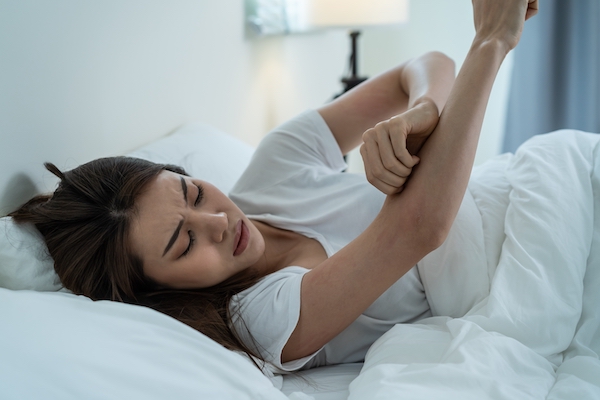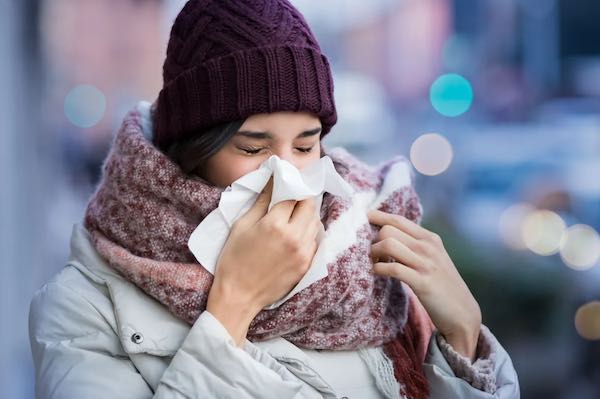You Only Have One Heart: A Young Woman’s Journey to Better Health
- Details
- Written by: Joanne Wallenstein
- Category: Health
 Written by Dr. Anthony Mercando, Cardiologist at White Plains Hospital
Written by Dr. Anthony Mercando, Cardiologist at White Plains Hospital
Many of us know that having high cholesterol can increase one’s risk for heart disease and stroke, as it can build up plaque in the arteries. While high cholesterol can often be remedied with lifestyle changes, including alterations to diet and exercise, in many cases, a patient’s genetics play a role in their cholesterol levels, and medical intervention is needed.
Such was the case for Amanda Bulfamante, 33, a New Rochelle-based hairstylist who has a family history of cardiac events as well as high cholesterol. “I've never been able to get my cholesterol under control, even after changing my diet and losing weight,” she shares. When Amanda experienced heart palpitations, she made an appointment to see Dr. Anthony Mercando, a board-certified cardiologist at White Plains Hospital Physician Associates in White Plains.
“When Amanda came in, we reviewed her personal health history as well as her family history,” he says. “Since members of her family have experienced heart attacks at a young age, it was especially important to fully evaluate her risk.” To get the most accurate picture of Amanda’s heart health, Dr. Mercando ordered a long-term electrocardiogram test and blood test to check her cholesterol levels. In addition, he ordered a test known as a lipoprotein (a), or LP(a) test.
While Amanda’s heart palpitations proved to be benign and did not require treatment, two indications of elevated cardiovascular risk were evident from her blood tests. She had “a very high cholesterol level, and elevated levels of LP(a),” shares Dr. Mercando.
While there is currently no approved treatment for lowering LP(a), “an elevated value of LP(a) in a patient tells me that other risk factors and other lipids need to be aggressively treated,” he explains. High levels of LP(a) typically run in families as well are associated with arterial sclerosis, or hardening of the arteries.
As part of Amanda’s treatment plan, she now takes a statin medication to bring her cholesterol down in addition to continuing to eat a balanced diet and exercising regularly. “For many patients with a genetic predisposition to high cholesterol, even if they live the healthiest lifestyle possible, medication is needed to get their cholesterol to a healthy range and lower their risk for heart disease,” says Dr. Mercando.
Amanda was hesitant to start a medication regimen, especially given her young age. “I was concerned about potential side effects, but Dr. Mercando helped to put me at ease,” she shares. “I know that I am being as proactive as I can to stay healthy.”
Complicating matters even further was a near-simultaneous diagnosis of Multiple Sclerosis. “The DMT (disease-modifying therapies) I’m taking for the MS are very strong medications, and we continue to monitor how I react to that and the statin medications that Dr. Mercando put me on.”
Even with regular trips to a cardiologist and a neurologist, Amanda says she feels much better by getting checked early. “My advice would be to just go and get checked,” she declares. “It's really important. Some people may not take their heart health seriously because they think, ‘Oh, nothing's going to happen to me because I’m young and I don’t smoke.’”
“Taking care of yourself is so important,” she concludes. “You only have one heart.”
“I encourage everyone to discuss their family history of heart disease with their loved ones,” adds Dr. Mercando.  Dr. Anthony Mercando“Genetics play an important role heart health, and taking a proactive approach as Amanda has can make a meaningful difference in living a longer and healthier life.”
Dr. Anthony Mercando“Genetics play an important role heart health, and taking a proactive approach as Amanda has can make a meaningful difference in living a longer and healthier life.”
Click here to learn more about White Plains Hospital’s Cardiac Services Program.
Dr. Anthony Mercando is a board-certified cardiologist at White Plains Hospital Physician Associates. To make an appointment, call 914-849-4800.
Health Matters
The original version of this article was published in Health Matters, a White Plains Hospital publication.
What Women Don’t Know About Heart Disease
- Details
- Written by: Dr. Jeannette L. Yuen
- Category: Health
 (Contributed by Dr. Jeannette L. Yuen, Cardiologist at White Plains Hospital)
(Contributed by Dr. Jeannette L. Yuen, Cardiologist at White Plains Hospital)
Although heart disease has long been the leading cause of death, both in the U.S. and worldwide, a Harris poll conducted on behalf of the American Heart Association (AHA) found that 51% of respondents were unaware of that fact. It is no surprise then that the AHA and healthcare providers continue to push education about the deadly disease each year during February, known as “American Heart Month.”
In the past, men have been more likely to be diagnosed with heart disease than women. Although there is more ongoing research to explore women’s risks of the condition, it was not until 1999 that the AHA and American College of Cardiology issued the first clinical report on preventing of heart disease in women. This lag is now mitigated by robust research with gender-specific studies.
Men and women present with heart disease in mostly similar manners, but the how’s and why’s differ. One major factor in this disparity is the presence of female hormones, particularly estrogen. Pre-menopausal women are less likely to develop heart disease, as estrogen increases the “good” cholesterol (HDL) so that the “bad” (LDL) cholesterol is proportionally lower. This helps to reduce plaque buildup and inflammation in the arteries, common causes of developing of heart disease.
Women in general have smaller bodies than men, with smaller internal organs, including hearts, and vascular structures so effects of medications and outcomes of procedures can differ from those of men. In addition, as all people age, hypertension (high blood pressure) becomes more prevalent, as aging arteries become less flexible and less resilient, negatively affecting blood flow. Weight gain can also occur as we age, as metabolism slows down and activity levels decline. Obesity can also lead to sleep apnea, a condition that remains underdiagnosed for both genders.
Like men, women present with the following symptoms:
• Chest pain or tightness (angina)
• Pain in the neck, shoulder, arm, or back
• Shortness of breath
• Fatigue
• Nausea (less common in men)
• Abdominal discomfort (less common in men)
Unfortunately, women often underreport these symptoms. Most women are caregivers and tend to place others’ needs ahead of their own, often minimizing their symptoms which may delay much-needed medical attention.
Women are also more likely to develop broken-heart syndrome (Takotsubo cardiomyopathy), where an intensely stressful event occurs and can result in a weakening of the heart muscle. Fortunately, this is often a reversible condition.
I highly recommend anyone experiencing such symptoms to see their physician as soon as possible or, if the symptoms are severe, to go to their local emergency department.
One can never be “too cautious” when it comes to heart health. I recently saw an older retiree who had suffered from chest pain for two weeks before seeking medical advice; she had been taking care of an ill family member. Unfortunately, she had developed congestive heart failure from a massive heart attack that was not treated in a timely fashion.
You may be surprised to learn that you can have a heart attack and not necessarily know it; these are called “silent heart attacks” and can be brought on by the same factors that cause symptomatic heart attacks:
• Diabetes
• Excess weight
• Family history of heart disease
• High blood pressure
• High cholesterol
• Lack of exercise
• Tobacco use Although doctors are always recommending giving up using tobacco, I want to emphasize that smoking can have profoundly negative effects on your heart and blood vessels. A recent study showed that women aged 18-49 who smoke are 13 times more likely than their non-smoking contemporaries (men in the same age group who smoke are 9 times more likely to suffer the same fate). In addition, those who have vaped are 19% more likely to develop heart failure than those who have never done it before.
Although doctors are always recommending giving up using tobacco, I want to emphasize that smoking can have profoundly negative effects on your heart and blood vessels. A recent study showed that women aged 18-49 who smoke are 13 times more likely than their non-smoking contemporaries (men in the same age group who smoke are 9 times more likely to suffer the same fate). In addition, those who have vaped are 19% more likely to develop heart failure than those who have never done it before.
As you can see, a delay in diagnosis can result in a delay in proper medical care, which in turn can result in a heart attack or stroke – with the attendant life-altering effects. Many of the seemingly insignificant symptoms can be a sign of serious illness. Do not become a statistic; learn about your risk for heart disease and how you can proactively address it.
Dr. Jeannette Yuen is a Cardiologist with Scarsdale Medical Group, seeing patients at the Harrison location. To make an appointment, please call 914-723-8100.
Health Matters
The original version of this article was published in Health Matters, a White Plains Hospital publication.
No Need to Flake Out: Avoiding Dry Skin in Cold Weather
- Details
- Written by: Joanne Wallenstein
- Category: Health
 (The following was submitted by Dr. ChangHyun (Mike) Kim, Dermatology at White Plains Hospital)
(The following was submitted by Dr. ChangHyun (Mike) Kim, Dermatology at White Plains Hospital)
As the weather grows colder, you may notice your body getting more itchy – or in some cases, skin flaking off or even cracking, particularly in such areas as your elbows and knees.
Unless it’s indicative of such diseases as psoriasis, eczema or dermatitis – in which case hopefully you’re already seeing a dermatologist – dry skin in and of itself is nothing to be too concerned about … although the itchiness and appearance may be unpleasant. The reason for dry skin during the cold months is simple: cold air holds less moisture, which means your skin will become drier. Indoor heaters can also dehydrate your skin.
To avoid such developments, I recommend the following:
Take brief, lukewarm showers or baths. This may seem counterintuitive when it’s cold outside, but just as hot air will dry out your skin, so too will hot water, which can leach out your body’s natural oils. Keeping the water temperature down will prevent additional dehydration, as will keeping your bathing brief. Pat yourself dry afterwards.
Apply moisturizing ointments or creams after drying off. I recommend doing this over your entire body each time you bathe. Try using thicker products instead of thinner ones, which tend to be watered down don’t have as great an effect. Lotions, which typically contain more water than oil, are also generally less effective for the same reason.
Use a humidifier. Such a device can be a great help throughout the day. When the environment around you is drier, your skin gets drier, too. And outdoor elements aren't the only factor — the heaters we turn on when the temperature drops can dry out the indoor air too.
Remember the age factor. The previous steps are encouraged for everyone, but keep in mind that as we age our skin naturally produces less oil and decreases our ability to retain moisture. Older people may want to consult with a dermatologist to make sure they’re taking the proper steps to avoid or reduce dry skin.
Don’t forget the sunscreen. Most of us are used to applying a sunscreen with an SPF of at least 30 during the summer. But just because you’re not lying on a beach doesn’t mean you should forego sunscreen during the winter. The sun and its UV rays are still there, even if it’s less intense, and while you’re usually well-wrapped when going outside (hat, coat, gloves), there may still be parts of your body exposed to the sun. Again, an SPF of 30 blocks approximately 97% of the sun’s rays.
What if you’ve already got dry-skin symptoms? I suggest the following steps:
Moisturize well at least 1 to 2 times a day. Moisturizing ointments and petroleum jelly may be the best solution, as they contain no water to dilute them.
Avoid products that contain alcohol and scents, such as deodorizing soaps; the chemicals in the latter can further dry out your skin.
Stay hydrated. Making sure you drink plenty of water is always a good idea; during the winter you can further avoid developing dry skin by drinking four to six cups of plain water each day. Your physician can help further refine that amount depending on your gender, weight, pre-existing conditions, and other factors. Changhyun Kim MDFollowing these steps can help you avoid or reduce dry skin. If you are still having difficulties after taking such steps, see a dermatologist. They can provide additional advice on how to enjoy the winter without all that itching and flaking.
Changhyun Kim MDFollowing these steps can help you avoid or reduce dry skin. If you are still having difficulties after taking such steps, see a dermatologist. They can provide additional advice on how to enjoy the winter without all that itching and flaking.
Dr. ChangHyun (Mike) Kim is a board-certified dermatologist at Scarsdale Medical Group in Harrison. To make an appointment, call 914.723.7800.
Health Matters: The original version of this article was published in Health Matters, a White Plains Hospital publication.
Winter Can Present ENT-Related Challenges
- Details
- Written by: Joanne Wallenstein
- Category: Health
 The following was submitted by Alanna Windsor, MD, Pediatric Otorhinolaryngology – Head and Neck Surgery
The following was submitted by Alanna Windsor, MD, Pediatric Otorhinolaryngology – Head and Neck Surgery
The arrival of cold weather and snow may mean relief from outdoor allergies, but that doesn’t guarantee you’ll have smooth sailing until spring returns. In fact, some year-round ear, nose and throat (ENT) issues can be exacerbated during the winter months, while other challenges may present themselves.
Any of the common respiratory infections can be burdensome when people are stuck indoors more than usual. That includes the common cold; sinus infections (sinusitis); asthma flare-ups; ear infections; strep throat; and bloody noses due to drier air.
In addition, allergies to indoor factors like dust mites, cockroaches, fungi, and pet dander can be felt more keenly and may require extra attention when cleaning. Vacuuming and dusting your living space regularly; using an air filter to control allergens; washing and drying your bedding weekly; and removing mold can all be very helpful. You may also want to wear a mask while doing these chores for extra protection.
As for the other factors listed above, I recommend the following:
Common cold and Sinusitis. Practice good hand hygiene with soap and hot water or hand sanitizer and avoid touching your eyes and mouth. Try to avoid people who have the cold, which can be difficult if you’re living in close quarters with them, and if you haven’t already, get a flu shot.
Asthma. When it gets colder, your asthma may actually get worse. Use a mask and/or scarf when outdoors to make sure you’re breathing in warm air. Use a humidifier when indoors, and continue using your inhaler when needed; if you do not have one and continue to have breathing problems, consult your to determine which kind will work best for you.
Ear infections. Viral infections can be more common during the winter, which may affect your ears. Usually an earache goes away within a few days, but if it persists or keeps coming back, consult a physician. For recurrent ear infections, or persistent fluid buildup in the middle ear, referral to an ENT specialist may be warranted.
Strep throat. Again, using a humidifier will help ease a dry/sore throat, as will staying hydrated (tea with honey and lemon can be especially beneficial). Blowing your nose frequently can help keep airways clear, and vitamin D has also been shown to be helpful. You may also want to rest your voice to avoid extra irritation.
Nosebleeds. Nasal saline sprays and a humidifier can help lower the risk of nosebleeds. Try not to blow your nose too hard, as that can rupture blood vessels inside your nose. Use a thin layer of petroleum jelly to help moisturize your nose.
In addition, many of these conditions can be at least partially controlled with over-the-counter decongestants, antihistamines and pain relievers like ibuprofen or acetaminophen. Children under 6 should not be given such medications without first speaking with your doctor.
Will these remedies completely eliminate wintertime suffering? Not necessarily; after all, there famously is no cure for the common cold. But they can help alleviate at least some of your symptoms. Being armed with the right medical advice and treatments can certainly help in keeping your holidays happy. Dr. Alanna Windosr
Dr. Alanna Windosr
Dr. Alanna Windsor specializes in otolaryngology and pediatric otolaryngology at The Children's Hospital at Montefiore (CHAM) and sees patients at White Plains Hospital’s Pediatric Specialists, located at 600 Mamaroneck Avenue in Harrison. To make an appointment, call 914-849-KIDS.
Health Matters
The original version of this article was published in Health Matters, a White Plains Hospital publication.
Reframing Your Thought Processes to Be a Happier You
- Details
- Written by: Joanne Wallenstein
- Category: Health
 Disappointments, challenges, frustration—who can avoid these? But how can you stay calm amidst chaos? Does being at peace mean giving up? The truth is, the only thing you can truly control is your mind. And when you master that, you connect with your inner self and unlock the power of your mind.
Disappointments, challenges, frustration—who can avoid these? But how can you stay calm amidst chaos? Does being at peace mean giving up? The truth is, the only thing you can truly control is your mind. And when you master that, you connect with your inner self and unlock the power of your mind.
Pragya Jindal is a Scarsdale based mindfulness coach and a certified life coach who has developed the program called ‘Power of your Mind’. Here she explains her approach and how it can help you to overcome anxiety, stress and self doubt to be a happier you.
What is the Power of Your Mind?
Although our lives today are far more comfortable than they were 100 years ago—with modern conveniences like electricity, automobiles, running water, heating and air conditioning,technology and advanced healthcare—many of us remain deeply unhappy. We have everything previous generations dreamed of, yet 33% of people globally experience daily stress, worry, or sadness. In the U.S., 77% of adults face physical symptoms caused by stress, including headaches, fatigue, and sleep issues.
Power of Your Mind is a program in happiness, self awareness and emotional wellness. It is my carefully curated course, consisting of 12 transformative sessions designed to help you achieve emotional balance and a happier life. As Louise Hay once said, “Your life is a reflection of your thoughts. If you change your thinking, you change your life. It’s as simple as that.”
In this program, you will learn to become aware of your mind and how it is creating your reality. You will discover how to shift negative thoughts and replace them with empowering ones. We become what we feed our subconscious mind. 'Power of your mind' offers a fresh perspective and equips you with practical tools to embrace a more positive way of thinking.
Tell us about yourself:
My pursuit for my own knowledge, wisdom and happiness had led me to journey inwards. I was born and raised in India. All my life, I had a feeling of sadness, anxiety despite having an easy childhood. In 2004, shortly after earning my degree in engineering, I embarked on a profound journey to uncover life’s deeper questions. Although the world seemed full of opportunities, I felt a sense of emptiness that led me to explore happiness, human potential, and the workings of the subconscious mind.
I discovered the transformative power of mantra meditation, which helped me unravel my thought patterns and understand how they shaped my reality. Drawing inspiration from books by thought leaders such as Napoleon Hill, Dr. Joseph Murphy, Eckhart Tolle, Wayne Dyer, and Neale Donald Walsch, I gained valuable insights into navigating life’s challenges with positivity and resilience.
In 2021, I brought these insights together to create Power of Your Mind—a transformative 12-session program inspired by my own journey. Each session mirrors the sequence in which my subconscious revealed its truths, forming a mosaic of self-awareness, authenticity, and purpose.
This is not a religious program, nor do I teach mantra meditation. Instead, it’s a powerful exploration of who we truly are. By cultivating awareness of ourselves, we unlock the transformative power to change our lives and align with happiness and fulfillment. I am a certified life coach.
What inspired you to develop the Power of Your Mind?
I discovered the power of the mind at a young age and learned to use it to stay calm and peaceful, even in the face of life’s challenges. I believe happiness is a choice—our thoughts are within our control, and we can always choose to think differently.
Over time, I watched friends and family struggle with various challenges—business setbacks, relationship issues, and more. Many were caught in cycles of negative thinking. At first, I felt frustrated, wondering why they couldn’t just think differently. But I soon realized that most people aren’t taught how to change their perspective or find peace amidst difficulty.
A turning point came when I helped a close friend navigate a tough three-year relationship. By guiding her to shift her mindset and approach, she transformed her situation entirely. That experience, paired with my passion for learning and teaching, became the foundation for Power of Your Mind.
My goal is to help others shift their thinking, break free from limiting beliefs, and discover the transformative power of their minds.
Discuss your process - what does a session involve?
The first complimentary discovery session is all about understanding the ‘seekers’ needs. I guide them how they can change their mindset if needed. Some people find most of their answers in this meeting. We together assess if the program is a good fit for them.
Power of Your Mind is structured in 12 sessions, each focusing on different aspects of self-awareness, such as power of emotions, acceptance, love, forgiveness, ego and more. I share insights and guide clients through practical exercises, using relatable examples to make these concepts accessible. Each session includes simple exercises, recommended readings, and reflection, encouraging clients to apply these techniques in their lives. We delve into reading os Dr Joseph Murphy, Tara Brach, Esther Hicks, Dr Wayne Dyer, Ekhart Tolle, Napoleon Hill and many more.
The session is held once per week, and so typically people finish the course in 12-16 weeks. https://www.powerofyourmind.life/pages/program can give you a glimpse into what each session holds.
Are the sessions conducted in groups or individually?
Most of my sessions are one-on-one to allow for individualized attention. However, I also welcome small groups, typically three to five people, especially if friends or family wish to take the journey together.
How do you help your clients to identify the underlying issues behind their problems?
The sessions are designed to create self awareness and self reflection.To make it simpler, each session brings a law of subconscious mind. For eg: In session 4, we talk about the power of faith. The law of subconscious mind is “Anything we have faith in, will come to pass.” This gradually leads us to understanding and exploring our limiting beliefs.
I guide clients to uncover limiting beliefs by asking questions that encourage self-reflection. Through this, they often recognize their negative thought patterns. For example, one client realized she had a limiting belief that ‘good things cannot happen to her’. This awareness helped her release these beliefs and make positive changes in her life. She was able to secure a better position in her company which she had been trying for years.
What are some of the issues that you have helped your clients to address?
I’ve helped clients overcome issues like stress, anxiety, and self-doubt. By understanding and reshaping their thought patterns, they learn to face challenges with confidence and resilience. The program equips them with tools to tackle daily obstacles, improve relationships, and foster a more fulfilling life. People have attracted jobs, partners, better resolution to their otherwise hopeless situations .
What makes Power of Your Mind different from other mindfulness programs?
'Power of your mind' is built on simplicity and directness. When we face challenges, we often turn to self-help books. While inspiring, they often leave us wondering how to apply them to our lives. 'Power of your mind' is different—it’s straightforward with easy to apply techniques. For example, when discussing forgiveness, we explore it as a selfish yet healing act, teaching the technique to forgive which is not mostly discussed.
We stay stuck in difficult situations for two reasons: resistance and fear. Power of your Mind teaches you how to accept, take necessary actions, and release fears. Each session introduces subconscious mind principles, helping participants find evidence in their own lives to validate them. Personal stories from my journey and others make these concepts relatable and meaningful.
Who would benefit the most from your sessions?
Power of Your Mind is a transformative program focused on happiness, self-awareness, and personal growth. It is designed for individuals who are genuinely seeking inner happiness, striving for personal growth, or looking to navigate challenging life situations.
This program is ideal for those who value self-care and are ready to look beyond the outer, tangible world to connect with their inner selves. True happiness and success require a willingness to work inwardly, and 'Power of your mind' provides the tools and guidance to help individuals embark on this powerful journey of self-discovery and transformation.
What is the overall goal of Power of Your Mind?
At Power of Your Mind , I believe that no matter what challenges you face, you can overcome them and find happiness. The goal is to help people become self-aware, realize the incredible power of their mind, and equip them with tools to create positive change. In each session, you’ll discover key principles of the subconscious mind and how it transforms habitual thoughts—both positive and negative—into reality.
To learn more and schedule your first complimentary session, contact Mindfullness Coach Pragya Jindal at [email protected], call 347-850-7078 and visit her website at www.powerofyourmind.life.










